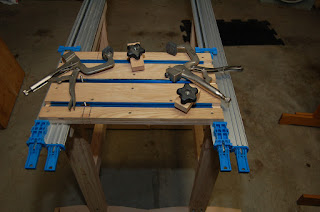While the basic Krenov is already quite useful in a small work shop, "accessorizing" it adds more utility. The latest version of the Krenov 2G with the top rail laid flat allows for added capability when I routed out a 3/4 inch channel to accommodate T-tracks. The T-tracks are flush to the flat surface so a double sided clamp can be installed as well for special but temporary applications. A hefty work bench is typically considered a must-have in a work shop. I have one but often, for much of what I do, it is either inadequate or way too much, which makes the space it occupies hard to justify. I don't do a lot of hammering and the chisel work and hand planing I do are considerably light. I do a lot of clamping for joinery and where mechanical fasteners are needed I use cordless drills. I find that 90 % of the operations do not necessarily require a work bench. For sure I can do clamping and driving screws without needing a work bench. And often the Krenov sawhorse or a flat table are all I need. And with a small work shop I would like to set aside certain things when I don't need them and that way I do not encroach into the area where the car is (garage). But if I have to I can always set up a temporary work area. The Krenov fits the bill.
Refer to previous blog for constructing the Krenov 2G.
 |
| I keep repeating myself but one must agree that the Krenov sawhorses do not require much storage space. There are two pairs of them shown here. |
 |
| An adjustable pair of clamps provide many work surface options; this is one example |
 |
| If a small but thick platform is needed, the adjustable clamps can secure it and more clamping options can be used. The thick board can reasonably handle hammer blows and chisel work. |
 |
| The double sided clamps allow the bottom section to clamp against the top rail while the top portion will have plenty of clamping options. |
 |
| More clamping options |
 |
| During construction of the Krenov 2, I made sure they were the same height as the "older" model to accommodate a wide board. A circular saw will cut this board safely. |
 |
| The next photos are just examples of what the Krenov will support. And don't forget how easy they were constructed and I assure the reader that the joinery provided by the pocket holes are very strong. |
 |
| The tops here are light weight but incredibly strong and rigid. Check the construction of the platform in "Torsion Box Construction" blog. |
 |
| These tops will not even flex under the weight of standard table top power tools. |